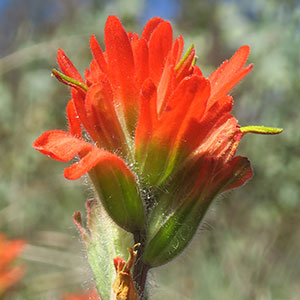Castilleja brevilobata
Castilleja elata
short-lobed paintbrush
Siskiyou Indian paintbrush, Siskiyou paintbrush, slender paintbrush
solitary or few, erect or ascending, unbranched, sometimes branched, hairs spreading, short, medium, and long, soft, short and medium ones short stipitate-glandular.
solitary, sometimes few, proximally creeping, becoming rhizomatous, distally ascending to erect, unbranched or branched, glabrous proximally, glabrate distally, hairs ascending, medium length, soft, eglandular.
green or ± yellow, lanceolate, elliptic, or oblong to narrowly ovate, 1–2(–2.5) cm, not fleshy, margins plane or wavy, involute, (0–)3–5(–7)-lobed, apex rounded to acute;
lobes ascending to erect, linear to lanceolate, apex rounded to acute.
widely spaced on stem, green, linear to lanceolate or narrowly oblong, 1.3–7.2 cm, not fleshy, margins plane, ± revolute, 0-lobed, apex broadly acute to acuminate, distalmost sometimes obtuse.
3–20 × 2–3.5 cm;
bracts proximally greenish to dull brown, distally red, orange-red, or scarlet, sometimes orange or yellow, broadly lanceolate or oblong, (0–)3–5-lobed;
lobes ascending, broadly to narrowly lanceolate, short, arising above mid length, apex acute, obtuse, or rounded.
2–13.5 × 1.5–4.5 cm;
bracts proximally greenish, rarely pink, distally pink, magenta, or purple, sometimes distally buff, dull yellow, cream, or light yellow-orange, ovate to elliptic or lanceolate, 0–5-lobed, sometimes also with 3 small teeth on center lobe;
lobes ascending or ± spreading, narrowly lanceolate to oblong, medium length, arising near or above mid length, apex acuminate to acute, sometimes obtuse.
straight, 15–24(–26) mm;
tube 12–16 mm;
beak exserted, abaxial lip equal to calyx;
beak adaxially green or ± yellow-green, 7–10 mm, puberulent, stipitate-glandular;
abaxial lip deep green, reduced, rounded, 1–2 mm, 10–25% as long as beak;
teeth incurved to erect, light green, 0.5–1 mm.
straight, 15–25 mm;
tube 7–12 mm;
beak and abaxial lip exserted above calyx lobes or ± pendently exserted from abaxial calyx cleft;
beak adaxially green to yellowish, 6–11 mm;
abaxial lip white to green, reduced, inconspicuous, pouches 3, small, 0.5–1.5 mm, 10–15% as long as beak;
teeth ascending, white to deep green, 0.5–1 mm.
green or whitish with green veins, lobes colored as bract lobes or paler, 14–30 mm;
abaxial and adaxial clefts 5.5–8.5 mm, 30–40% of calyx length, deeper than laterals, lateral 1.5–4 mm, 20–25% of calyx length;
lobes oblong to narrowly triangular, apex obtuse to rounded.
whitish, green, or pink, pale colored ones tending to age pink, lobes as in bracts, 9–17 mm;
abaxial and adaxial clefts 4.5–8 mm, 50% of calyx length, deeper than laterals, lateral 2–3 mm, 17–22% of calyx length;
lobes linear to oblanceolate, apex acute.
= 24.
= 24.
Castilleja brevilobata
Castilleja elata
Castilleja brevilobata is endemic to dry serpentine openings in the Siskiyou Mountains of southwestern Oregon and adjacent California. Although sometimes treated as part of C. applegatei or C. hispida, its morphology does not suggest a close connection with either. This species occasionally hybridizes with C. pruinosa in Del Norte County, California.
(Discussion copyrighted by Flora of North America; reprinted with permission.)
Castilleja elata is endemic to the Siskiyou Mountains of northwestern California and adjacent Oregon. Although often treated as a subspecies of C. miniata, it differs from that species in its shorter corolla beaks and distinctive bimodal coloration, with some populations exclusively pale yellow to pale orange and others pink-purple to magenta, as well as its specialized habitat in serpentine wetlands, where it often grows alongside Darlingtonia californica. Castilleja miniata grows on more mesic to moderately xeric substrates in the general vicinity of C. elata but with no sign of intergradation between the two species. The origin and significance of the two discrete color forms of C. elata deserve further study.
(Discussion copyrighted by Flora of North America; reprinted with permission.)


